Brachychiton Tree: [Planting, Care, Watering, Substrate]
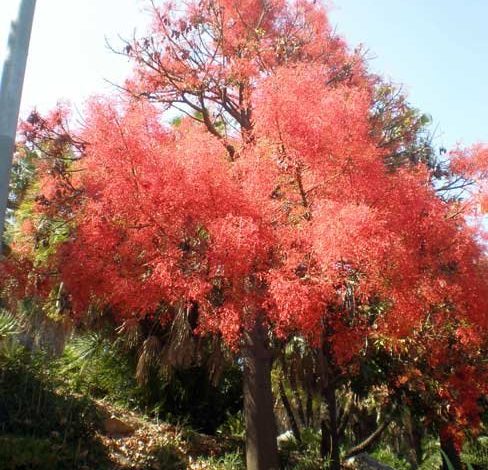
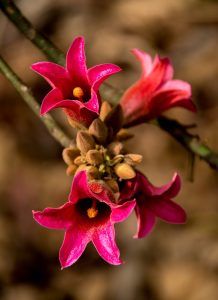 The Brachychiton (kurrajong, bottle tree) is a genus of 31 species of trees and large shrubs, native to Australia (the center of diversity, with 30 species), and New Guinea (one species).
The Brachychiton (kurrajong, bottle tree) is a genus of 31 species of trees and large shrubs, native to Australia (the center of diversity, with 30 species), and New Guinea (one species).
Fossils from New South Wales and New Zealand are estimated to be 50 million years old, corresponding to the Paleogene.
It is a tree that has been considered ornamental because of how beautiful it can be. It does not need much care.
Important points when planting the Brachychiton tree
- The family: Malvaceae.
- Scientific name: Brachychiton acerifolius.
- Plant type: Small tree, Large tree.
- Height: 10 ~ 40 meters.
- Width: 5 ~ 15 meters.
- Flower color: Red.
- Flowering time: spring, summer.
- Ph level: Acid, Neutral.
- Type of soil: loam, sandy loam, clay loam.
- Climate zone: Subtropical, Warm temperate, Cold temperate, Mediterranean.
- Light: Sunny, light shade.
- Growth Habit: Deciduous, spreading.
- Soil Moisture: Well – drained, moderately moist drainage.
- Propagation method: Seed.
- Frost tolerance: Light.
- Use of the plant: Ornamental.
- Special uses: Edible, Street tree.
- Attracts wildlife: Bees, Birds that eat nectar, Butterflies, Other insects.
Characteristics of the brachychiton
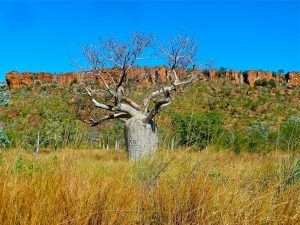 They grow up to 4 – 30 m tall, and some are dry season deciduous. Several (but not all) species are peaceful plants with a very robust stem for their general size, used to store water during periods of drought.
They grow up to 4 – 30 m tall, and some are dry season deciduous. Several (but not all) species are peaceful plants with a very robust stem for their general size, used to store water during periods of drought.
Leaves show intraspecific variation and are generally entire to deeply palmate with long, slender leaf-like lobes attached only at the base.
Its size varies between 4 and 20 cm in length and width. It is very common in Australia.
All species are monoecious with separate male and female flowers on the same plant . The flowers have a bell-shaped perianth consisting of a single series of fused lobes that is considered a calyx despite being brightly colored in most species.
The female flowers have five separate carpels that can each form a woody fruit containing several seeds. Flower color is often variable within each species. Eastern woodland species drop their foliage before flowering, but those in drier regions bear the flowers while they are in leaf.
A few species of Kurrajong, as the tree is known in the Dharuk language, are popular garden trees and have been introduced to hot, dry regions such as the Mediterranean, South Africa, and the western United States.
These species are also hybridized for horticultural purposes, B. populneo-acerifolius being an example.
Kurrajongs are known to flower erratically in cultivation.
prepare the land
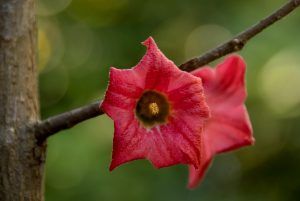 Shop soil for succulents is suitable with a small addition of sand.
Shop soil for succulents is suitable with a small addition of sand.
For a self-prepared mix, take: three parts coarse sand or perlite, two parts garden soil, two parts humus (leafy soil), one part charcoal and bone meal, lime or a little eggshell.
Good drainage is required. The ideal pH is 5.5 – 6.5.
Brachychiton irrigation
Due to its amazing water storage capacity, the Queensland Bottle Tree is drought and wind tolerant, but may drop some leaves during periods of drought.
The healthiest plants are known to grow in areas that experience prolonged dry spells as the roots will grow very deep in search of water.
Plant a brachychiton tree step by step
- Plant the bottle tree in fertile, well-drained soil and in full sun. Avoid rocky planting locations. Choose an area with plenty of vertical space to allow for its mature height of 45 feet. Space the tree 30 feet away from other trees and buildings.
- Water the tree deeply every 14 days during the spring and fall months and every seven days during the summer months.
- Soak the surrounding soil with a garden hose. Let the water drain through the soil, leaving the soil completely moist. Don’t let the soil become soggy with standing water.
- Fertilize the tree during the spring, just before new growth begins, with a 10-10-10 nitrogen, phosphorous and potassium slow-release type fertilizer.
- Spread the fertilizer as evenly as possible in a ring around the tree.
- Select the strongest vertical branch, or central leader, of the tree. Prune all other leaders to create a strong upright trunk. Eliminate the leaders of the competition every three years.
- Prune bottle trees in early spring while the tree is still dormant. Use hand pruning shears on branches. Use loppers or a pruning saw on all larger branches. Remove any broken, dead, or diseased branches. Prune lower branches that impede traffic. Make each cut above a lateral branch, with the bud facing out or the circular neck surrounding the base of the branch.
Brachychiton care
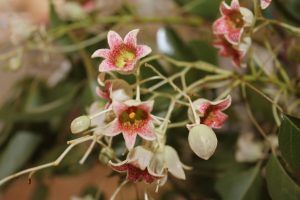 The brachychiton tree requires very little, if any, care and maintenance. Although it is drought tolerant, it likes to be watered regularly during the summer.
The brachychiton tree requires very little, if any, care and maintenance. Although it is drought tolerant, it likes to be watered regularly during the summer.
Feeding is not usually necessary unless pot grown, but can be fed with a balanced complete fertilizer once a year, usually in spring, to maintain vigour.
Plagues and diseases
The brachychiton tree is generally free of pests and diseases, but feeding can encourage bushy, bushy growth that may attract the Kurrajong leaf-roller caterpillar or birds seeking shelter.
All in all, it is affected by spider mites, scale insects, and whiteflies.
Root rot is possible with excessive watering.
It suffers from a lack of light – it grows slowly, the shoots stretch, the leaves become less, turn pale. Young plants can suffer from excess light because sunburn occurs on the leaves.
Pruning
Pruning is also not necessary but will respond well to light pruning if planted in a situation where size or shape control is needed.
The tree can drop its leaves before flowering, usually between the months of September and December. This will give rise to a new flush of fresh leaves and give the tree a new burst of life.
Thanks to their slow growth, brachychiton trees can be grown as container plants or made into bonsai. Its unique shape creates a conversation piece even for people who would not normally be interested in plants.
These bottle trees are hardy, and also drought and sun tolerant. They are a perfect tree for the xeriscape landscape, requiring little care once established.
Caution: The juice that is released during pruning irritates the skin, so contact with the eyes must be avoided.
The reproduction of the brachychiton
The most suitable way is to multiply the seeds soaked for 24 hours, which are planted in a mixture of peat, perlite and sand.
They sprout at high temperature and not in the light. It sprouts between one and three weeks, but altogether they take quite a long time.
When the seedlings reach a height of 2.5 cm, they are submerged and transplanted into a small pot. It is also propagated by cuttings about 12 cm long, which, after drying, are placed in a loose substrate of sand, moss and perlite with the addition of fungicide. It is covered with a film.
Types of brachychiton
Brachychiton acerifolius
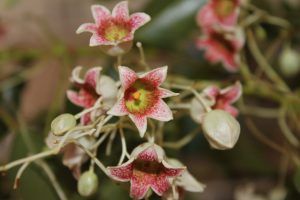 Large tree: 20-30m tall. Masses of bright red, bell-shaped flowers in late spring and early summer.
Large tree: 20-30m tall. Masses of bright red, bell-shaped flowers in late spring and early summer.
Adapts to a wide range of soil types.
Brachychiton Beau Bells
Small tree: 4m-5m high x 2m-3m wide. Clusters of deep pink bell flowers in late spring and early summer.
Adapts to a wide range of soil types. Tolerant to drought and frost. Magnificent tree with a brilliant display of flowering.
Brachychiton Belladonna
Medium tree: 5m-10m high x 4m-6m wide.
Masses of large, delicate pink flowers in late spring and early summer. Adapts to a wide range of soil types.
Tolerant to drought and frost. Superb feature tree.
Brachychiton bidwillii
Small bushy tree: 4m-5m high x 2m-3m wide.
Clusters of star-shaped red flowers in late spring and early summer. The lobed leaves are deep green with pinkish new growth.
They adapt to a wide range of soil types. Tolerant to drought and frost.
Brachychiton Clarabelle
Small tree: 4m-6m high x 2m-3m wide. Clusters of red/pink star-shaped bell flowers in late spring/early summer.
Lobed leaves are deep green with pinkish new growth. They adapt to a wide range of soil types.
Tolerant to drought and frost. Magnificent tree with a brilliant display of flowering.
Brachychiton Griffith Pink
Small tree: 5m-8m high x 2m-3m wide.
Glossy, deep green foliage with clusters of large pink bell flowers in late spring/early summer. Adapts to a wide range of soil types. Resistant to drought and frost down to -7C. It adapts well in South Australia.
Brachychiton Noel’s surprise
Small tree: 4m-5m high x 2m-3m wide.
Clusters of bright red/pink bell-shaped flowers. Blooming from early spring to early summer.
Deciduous tree with bright, deep green foliage. Adapts to a wide range of soil types. Tolerant to drought and frost. Superb feature tree with a brilliant display of flowering.
Brachychiton Jasper Bell
Small tree: 4m-6m high x 2m-3m wide.
Clusters of orange /pink bell flowers are carried in arms and up the trunk in late spring and early summer.
Adapts to a wide range of soil types. Tolerant to drought and frost. Magnificent tree with a brilliant display of flowers.
Brachychiton spectablis
Small tree: 4m-6m high x 2m-3m wide.
Clusters of orange/pink bell flowers are carried in arms and up the trunk in late spring and early summer. The lobed leaves are deep green with pinkish new growth. They adapt to a wide range of soil types.
Tolerant to drought and frost. Superb feature tree with a brilliant display of flowering.
How long does the brachychiton tree live?
It is a relatively long-lived species that can live an average of 100 years.
Under ideal conditions, it may even reach 150 years.
How long does it take for the brachychiton tree to grow?
The brachychiton grows quickly, especially at the beginning of the process, being able to look like an adult tree after 7 years.
How long does it take to produce fruit?
A brachychiton can spend up to 5 years without producing flowers in most cases. That means that it will not bear fruit either.
Even when the growing conditions or care are not appropriate, the tree could grow and have leaves, but never produce flowers.
Can it be grown in a pot?
It is possible to have it in a pot in its first years of life. However, after it reaches a certain height it is advisable to transplant it into the garden due to its large size.
He also agrees to be worked as a bonsai.
How many times does the brachychiton tree produce fruit?
It produces fruits once a year in the period from summer to autumn.
Should brachychiton tree be pollinated to get fruit?
Yes, you have to pollinate it. It is an entomophilous species that uses the service of insects for this process.
How cold can the brachychiton tree tolerate?
Yes, it can resist the cold and even an eventual frost, as long as it does not last for too long.
How many brachychitons trees can be planted per hectare?
Depending on the characteristics of the crown and the dimensions that the trunks are allowed to reach, between 100 and 150 specimens per hectare can be planted.
What kind of fertilizer does the brachychiton tree need?
In general, it does not require obligatory fertilization, especially when it is an adult.
Granular fertilizers can be applied in case of planting in very poor soil.
How much heat and/or drought can the brachychiton tree tolerate?
It is resistant to intense heat. In fact, there are specimens that have survived temperatures of 40° C.
Regarding the subject of drought, there are not many problems either, since it can tolerate them with hardly any damage.

![Photo of The Ivy: [Planting, Irrigation, Care and Substrate]](https://www.complete-gardening.com/wp-content/uploads/2022/08/the-ivy-planting-irrigation-care-and-substrate-390x220.jpg)
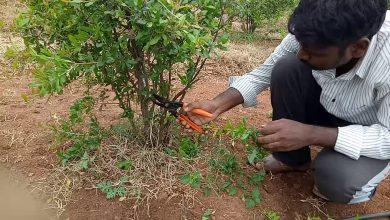
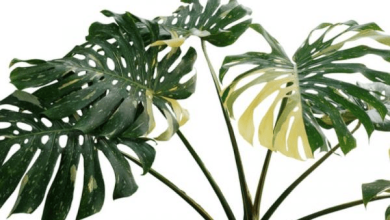
![Photo of Anise: [Cultivation, Irrigation, Care, Pests and Diseases]](https://www.complete-gardening.com/wp-content/uploads/2022/08/anise-cultivation-irrigation-care-pests-and-diseases-390x220.png)